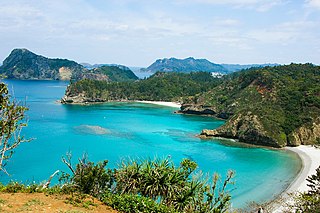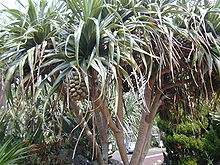
Magnolia is a large genus of about 210 to 340 flowering plant species in the subfamily Magnolioideae of the family Magnoliaceae. The natural range of Magnolia species is disjunct, with a main center in east, south and southeast Asia and a secondary center in eastern North America, Central America, the West Indies, and some species in South America.

Lauraceae, or the laurels, is a plant family that includes the true laurel and its closest relatives. This family comprises about 2850 known species in about 45 genera worldwide. They are dicotyledons, and occur mainly in warm temperate and tropical regions, especially Southeast Asia and South America. Many are aromatic evergreen trees or shrubs, but some, such as Sassafras, are deciduous, or include both deciduous and evergreen trees and shrubs, especially in tropical and temperate climates. The genus Cassytha is unique in the Lauraceae in that its members are parasitic vines. Most laurels are highly poisonous.

Araucaria is a genus of evergreen coniferous trees in the family Araucariaceae. While today they are largely confined to the Southern Hemisphere, during the Jurassic and Cretaceous they were globally distributed. There are 20 extant species in New Caledonia, eastern Australia, New Guinea, Argentina, Brazil, Chile and Uruguay.

The Bonin Islands, also known as the Ogasawara Islands (小笠原諸島), is a Japanese archipelago of over 30 subtropical and tropical islands located around 1,000 kilometers (620 mi) SSE of Tokyo and 1,600 kilometers (1,000 mi) northwest of Guam. The group as a whole has a total area of 84 square kilometers (32 sq mi) but only two of the islands are permanently inhabited, Chichijima and Hahajima. Together, their population was 2,560 as of 2021. Administratively, Tokyo's Ogasawara Subprefecture also includes the settlements on the Volcano Islands and the Self-Defense Force post on Iwo Jima. The seat of government is Chichijima.

Cryptomeria is a monotypic genus of conifer in the cypress family Cupressaceae. It includes only one species, Cryptomeria japonica. It used to be considered by some to be endemic to Japan, where it is known as Sugi. The tree is called Japanese cedar or Japanese redwood in English. It has been extensively introduced and cultivated for wood production on the Azores.

Philodendron is a large genus of flowering plants in the family Araceae. As of June 2013, the Plants of the World Online accepted 621 species; other sources accept different numbers. Regardless of number of species, the genus is the second-largest member of the family Araceae, after genus Anthurium. Taxonomically, the genus Philodendron is still poorly known, with many undescribed species. Many are grown as ornamental and indoor plants. The name derives from the Greek words philo- 'love, affection' and dendron 'tree'. The generic name, Philodendron, is often used as the English name.

Pandanus is a genus of monocots with about 578 accepted species. They are palm-like, dioecious trees and shrubs native to the Old World tropics and subtropics. Common names include pandan, screw palm and screw pine. They are classified in the order Pandanales, family Pandanaceae.

The Ogasawara subtropical moist forests is a terrestrial ecoregion which encompasses the Ogasawara Archipelago of Japan. The Ogasawara Archipelago lies in the Pacific Ocean south of Honshu, Japan's largest island, and north of the Marianas Islands. The ecoregion includes the Bonin Islands and Volcano Islands chains. The islands are volcanic in origin, and have never been linked to a continent. They are home to distinct plants and animals including many endemic species.

Acer is a genus of trees and shrubs commonly known as maples. The genus is placed in the soapberry family Sapindaceae. There are approximately 132 species, most of which are native to Asia, with a number also appearing in Europe, northern Africa, and North America. Only one species, Acer laurinum, extends to the Southern Hemisphere. The type species of the genus is the sycamore maple Acer pseudoplatanus, one of the most common maple species in Europe. Most maples usually have easily identifiable palmate leaves and all share distinctive winged fruits. The closest relative of the maples is the small east Asian genus Dipteronia, followed by the more widespread genus Aesculus. Maple syrup is made from the sap of some maple species. It is one of the most common genera of trees in Asia. Many maple species are grown in gardens where they are valued for their autumn colour and often decorative foliage, some also for their attractive flowers, fruit, or bark.

Ulmus wallichianaPlanch., the Himalayan elm, also known as the Kashmir elm and Bhutan elm, is a mountain tree ranging from central Nuristan in Afghanistan, through northern Pakistan and northern India to western Nepal at elevations of 800–3000 m. Although dissimilar in appearance, its common name is occasionally used in error for the cherry bark elm Ulmus villosa, which is also endemic to the Kashmir, but inhabits the valleys, not the mountain slopes. The species is closely related to the wych elm U. glabra.

Ulmus changii, occasionally known as the Hangzhou elm, is a small deciduous tree found across much of China in forests at elevations of up to 1800 m. Owing to its increasing scarcity, U. changii was added to the Hainan Province Protected Plants List in 2006.

Marcescence is the withering and persistence of plant organs that normally are shed, and is a term most commonly applied to plant leaves. The underlying physiological mechanism is that trees transfer water and sap from the roots to the leaves through their vascular cells, but in some trees as autumn begins, the veins carrying the sap slowly close until a layer of cells called the abscission layer completely closes off the vein allowing the tree to rid itself of the leaf. Leaf marcescence is most often seen on juvenile plants and may disappear as the tree matures. It also may not affect the entire tree; sometimes leaves persist only on scattered branches. Marcescence is most obvious in deciduous trees that retain leaves through the winter. Several trees normally have marcescent leaves such as oak (Quercus), beech (Fagus) and hornbeam (Carpinus), or marcescent stipules as in some but not all species of willows (Salix). All oak trees may display foliage marcescence, even species that are known to fully drop leaves when the tree is mature. Marcescent leaves of pin oak complete development of their abscission layer in the spring. The base of the petiole remains alive over the winter. Many other trees may have marcescent leaves in seasons where an early freeze kills the leaves before the abscission layer develops or completes development. Diseases or pests can also kill leaves before they can develop an abscission layer.

The Bonin white-eye is a small species of songbird endemic to the Bonin Islands of Japan. It is the only species in the monotypic genus Apalopteron. The taxonomic affinities of the Bonin white-eye were a long-standing mystery and it was formerly placed with the bulbuls, babblers and more recently with the honeyeaters, during which it was known as the Bonin honeyeater. Since 1995 it is known to be a white-eye in the family Zosteropidae, that is closely related to the golden white-eye of the Marianas Islands.

The American Elm cultivar Ulmus americana 'Princeton' was originally selected in 1922 by New Jersey nurseryman William Flemer of Princeton Nurseries for its aesthetic merit. 'Princeton' was later found to have a moderate resistance to Dutch elm disease (DED).

The American Elm cultivar Ulmus americana 'Columnaris' was propagated by R. E. Horsey of the Rochester N.Y. Parks Department from a tree found by Mr John Dunbar at Conesus Lake, New York, in 1911, and originally described as a forma, Ulmus americana L. f. columnaris, f. nov.Rehder (1922). It was the earliest of a number of compact, columnar American elm cultivars, to be followed by 'Ascendens' and 'Augustine Ascendening'.

The Bonin flying fox, also known as Bonin fruit bat, is a species of flying fox in the family Pteropodidae. It is endemic to four islands of the Bonin Islands group, Japan. Its natural habitat is subtropical forests. It is threatened by habitat loss.

Ficus aurea, commonly known as the Florida strangler fig, golden fig, or higuerón, is a tree in the family Moraceae that is native to the U.S. state of Florida, the northern and western Caribbean, southern Mexico and Central America south to Panama. The specific epithet aurea was applied by English botanist Thomas Nuttall who described the species in 1846.

Allium thunbergii, Thunberg's chive or Thunberg garlic, is an East Asian species of wild onion native to Japan, Korea, and China. It grows at elevations up to 3000 m. The Flora of China recognizes A. tunbergii and A. stenodon as separate species, but more recent sources combine the two.
Metrosideros boninensis is a species of flowering plant in the family Myrtaceae. It is endemic to the Bonin Islands archipelago and is found exclusively on Chichijima Island, excepting for two remaining trees located on neighboring Anijima Island. M. boninensis is classified as ‘endangered’ in the Japanese Red Data Book and, although there were 326 plants recorded in 2004, genetic diversity of M. boninensis is extremely low.

The Bonin Islands are an archipelago of over 30 subtropical and tropical islands, some 1,000 kilometres directly south of Tokyo, Japan and 1,000 miles northwest of Guam.


















